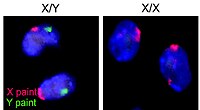
Photo from wikipedia
Isolating discrete populations of germ cells from the mouse testis is challenging, because the adult testis contains germ cells at every step of spermatogenesis, in addition to somatic cells. We… Click to show full abstract
Isolating discrete populations of germ cells from the mouse testis is challenging, because the adult testis contains germ cells at every step of spermatogenesis, in addition to somatic cells. We present a novel method for isolating precise, high-purity populations of male germ cells. We first synchronize germ cell development in vivo by manipulating retinoic acid metabolism, and perform histological staging to verify synchronization. We use fluorescence-activated cell sorting to separate the synchronized differentiating germ cells from contaminating somatic cells and undifferentiated spermatogonia. We achieve ~90% purity at each step of development from undifferentiated spermatogonia through late meiotic prophase. Utilizing this "3 S" method (synchronize, stage, and sort), we can separate germ cell types that were previously challenging or impossible to distinguish, with sufficient yield for epigenetic and biochemical studies. 3 S expands the toolkit of germ cell sorting methods, and should facilitate detailed characterization of molecular and biochemical changes that occur during the mitotic and meiotic phases of spermatogenesis.
Journal Title: Developmental biology
Year Published: 2018
Link to full text (if available)
Share on Social Media: Sign Up to like & get
recommendations!